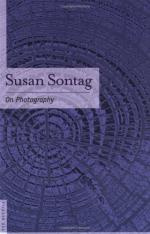
|
| Name: _________________________ | Period: ___________________ |
This test consists of 15 multiple choice questions and 5 short answer questions.
Multiple Choice Questions
1. Whitman wanted people to begin to see that they needed to accept the _________ within the society.
(a) Music.
(b) Horror.
(c) Real.
(d) Happiness.
2. Surrealism seeks to document and to reconnoiter ___________, much in the same way that photography does.
(a) Class.
(b) Animals.
(c) Society.
(d) Books.
3. In large measure, photography has replaced experiential interaction with __________, according to the book.
(a) The ether.
(b) True desire.
(c) God.
(d) The world.
4. A photograph can only convey ____________of something, but gives no real information about the subject.
(a) A word.
(b) A shape.
(c) A picture.
(d) A sense.
5. Some photographers are _________, seeking to clarify or to identify a world vision.
(a) Moralists.
(b) Students.
(c) Teachers.
(d) Scientists.
6. Photography yields to viewers _____________ to look and to act as a sort of voyeur without repercussion.
(a) A push.
(b) Permission.
(c) A need.
(d) A desire.
7. What was the profession or the career choice for Whitman during his time in the world?
(a) President.
(b) Poet.
(c) Chemical engineer.
(d) Novelist.
8. Photography presupposes that _____________ can be a comprehensible totality, according to Sontag.
(a) People.
(b) Children.
(c) Reality.
(d) Nature.
9. Photography often makes the photographer incapable of _____________ - one can either document or do something else.
(a) Closing their eyes.
(b) Committment.
(c) Feeling.
(d) Intervention.
10. Photography has made the world unable to perceive the _________ beyond the photograph, according to Sontag.
(a) Land.
(b) Emotions.
(c) Real world.
(d) Colors.
11. Like modern art, according to Sontag, photography lowers ___________ in those who view it.
(a) Understanding.
(b) Inhibitions.
(c) Trust.
(d) Sensitivities.
12. The camera's drive toward enabling _______________ use promotes the use of photography as a means of pornography.
(a) Silly.
(b) Untrained.
(c) Illegal.
(d) Darkened.
13. The art of taking documentary photographs instead of helping a situation is a tacit ____________ that whatever is going on should keep on happening.
(a) Permission.
(b) Joy.
(c) Encouragement.
(d) Denial.
14. The surrealist movement courts _________ and incongruous juxtaposition in its use.
(a) Truth.
(b) Reality.
(c) Justice.
(d) Accidents.
15. Photography also establishes what is allowable as an object of ____________, according to Sontag.
(a) Worth.
(b) Pity.
(c) Deity.
(d) Inspection.
Short Answer Questions
1. What picture of Steichen's was composed of portraiture that showed the universal in the individual?
2. As the text says, "Hobbesian man roams the streets, quite visible, with ____________ in his hair."
3. What are the shadows in the cave shadows of, according to the book?
4. _____________ often use cameras and practice photography as a method of certifying their travel experience.
5. A photograph seems to be taken in order to guarantee that the event has actually ___________.
|
This section contains 403 words (approx. 2 pages at 300 words per page) |

|




